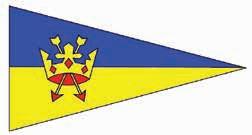
















A CENTURY OF SAILING WALDRINGFIELD SAILING CLUB 1921-2021 D C E W Y
Published by Robert Deaves 2022













Copyright © Robert Deaves, Waldring eld Sailing Club 2022



ISBN: 978-1-912724-26-0

All rights reserved. No part of this publication may be reproduced, stored in a retrieval system or transmitted in any form by any means, electronic, mechanical, photocopying, recording or otherwise without the prior written permission of the publisher and the copyright holders.







4
Contents
Brief history of 100 years of WSC
I – Introduction – A century of sailing
II - Background to the formation of the Club
III - Between the Wars – 1921 to 1939
IV – The Waldringfield Designers
V – The Clubhouse
VI – Fifty years of Squibbing
VII – Building the Club – 1945-1971
VIII – The Waldringfield Dragonfly
IX - Land and property
X – The OK Dinghy XI – Training XII – Consolidation 1972-1996










XIII -
XIV – They built this club on eggy baps
XV – The Cadet story
XVI - Fairway Committee
XVII - Club events
XVIII - Wayfarers
XIX – Independence – 1997-2021
XX – The Laser
XXI - Family club
XXII – Yachts and Yacht classes






XXIII - The RS200 class
XXIV - Cruising
XXV - Racing at Waldringfield
XXVI - Success and influence
XXVII – Trophies and winners
XXIX – Flag officers
XXX – The Club at 100
XXXI - Acknowledgements
5
D C E W Y

IIntroduction –A century of sailing















In 2021 Waldring eld Sailing Club celebrated its centenary year – 100 years of sailing, racing and success on the picturesque River Deben in Su olk, at the heart of a small village. It takes some considerable e ort, commitment and enthusiasm for anything to last 100 years, and the fact that Waldring eld Sailing Club survived to celebrate its centenary is a lesson in determination, resolve and dedication, as well as absolute love of sailing on a beautiful stretch of a largely undeveloped river. ere were many celebrations at Waldring eld over the course of the centenary year, which was held against the background and restrictions of the coronavirus pandemic. e highlight of the year, however, was the Centenary Regatta Weekend in June, with a full racing programme as well as the traditional Sail Past at the clubhouse on the Saturday a ernoon. Many stories were told that weekend and throughout the year and many form part of this book, celebrating the life of a club that has meant so much to so many people for 100 years.
BEGINNINGS
e formation of what was originally called the Waldring eld and Hemley Sailing Club came a er a period of heavy industry in the village. e Cement Works behind the Quay had closed in 1907 and following the end of the First World War, leisure pursuits, especially sailing and racing, became more popular.
As Waldring eld emerged from this era increasing numbers of people – residents, visitors and labourers – would take to the river in small cra for fun. Some would go on to construct riverside huts just behind
Opposite: Waldringfield Sailing Club dressed up for the Centenary Regatta in 2021

Below: Cententary Sail Past in 2021 with Cadets, Toppers and Mirrors following Boadicea (Robert Deaves)
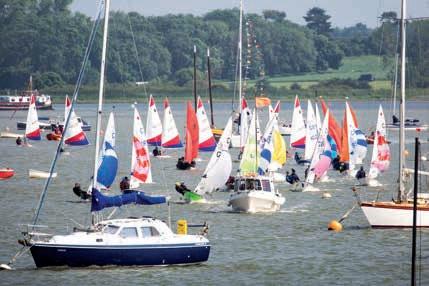
11
D C E W Y
Waldring eld beach where the cli s had been levelled during excavations for coprolite. ere was limited racing on the river before this time, and some regattas organised at Waldring eld, but it wasn’t until 1921 that like-minded sailors came together to create a sailing club.
Waldring eld and Hemley Sailing Club was founded following a meeting at Gorse Cabin, one of the huts along the Waldring eld foreshore, sometime in 1921, though the date is obscured and many early documents and programmes mistakenly state the Club was formed in 1922. Gorse Cabin would serve as the Club’s base and makeshi clubhouse for the next ten years, and most of it is still standing as an open shelter to the south of the current clubhouse.
e famed engineer Cli ord Paterson was appointed the rst President, with boatbuilder Harry Nunn as Secretary and omas Naunton Waller, son of the village rector Rev. omas Henry Waller, as the Treasurer. Alfred William Stollery, of Gorse Cabin, became Chairman and Arthur
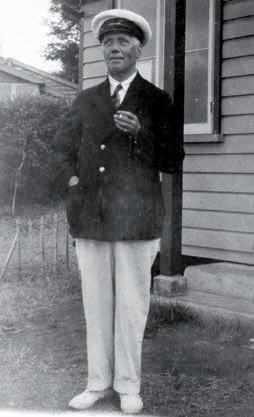
Quantrill, R. Button Jnr and C. Rix were on the committee.
Some of the early rules of the club stated that o cers must be residents of Waldring eld or Hemley or those that made Waldring eld or Hemley their summer residence. Non-residents could be members but had no voting rights.
Gorse Cabin was an army surplus Nissen hut, bought by Alfred Stollery in 1919. As Waldring eld Sailing Club grew, another Nissen hut was bought and erected nearby, before building began on the site of the present clubhouse in 1932. ese inauspicious beginnings spawned a thriving and in uential sailing club that has evolved into one of the most successful in the country and produced many national and world champions.
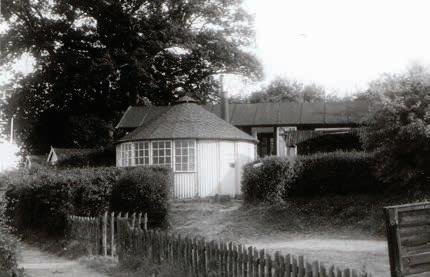
GROWTH
e rst purpose-built clubhouse was a two storey, three room, wooden building, and was opened in 1932 a er much fundraising and negotiations with the church that owned the land. is building was extended, modi ed, renovated and improved for the next y years, until in 1982, a brand-new brick clubhouse was opened. is was extended again in 1989 and 2012 to create the facility the Club enjoys today. e clubhouse as it exists today owes much of its design to that very rst clubhouse in 1932. Even though nothing remains of that rst building today’s front door is in the same place as that rst front door, though there have been several front doors since. e original clubhouse contained little more than a small lobby and meeting room with a crow’s nest on top. e current entrance hall is more or less in the same place, while the main club room built in 1949 is also where today’s main clubroom sits. e crow’s nest, and the starting line, have also maintained the same position, through several redesigns, extensions and rebuilds since 1932. roughout most of its history the Club leased land from the church, as much of the land in and around Waldring eld was Glebe and owned and managed by the church. e history of the Club is also inextricably linked with the Waller family as the largest landowner in the area as well as long-term incumbents of the local church, which until 1976 was responsible for
12 A CENTURY OF SAILING – WALDRINGFIELD SAILING CLUB 1921-2021
Above: Gorse Cabin in 1970 (Maureen Shephard)
Below: Alfred Stollery in 1932
leasing the land for the clubhouse and dinghy park to the Club.
Until 1979 the Club had very little control over its destiny as it relied on the shortterm leases being renewed every few years with the incumbent rector or the Church Commissioners. However, in 1979 Peter Fraser negotiated a 30-year lease, and this opened huge opportunities for the Club to plan ahead and paved the way for it nally buying and owning the land 20 years later. At the same time, the Club also negotiated a 30-year lease on the car park from the owners of the Maybush public house. O ering members a car park had been one of the biggest stumbling blocks to longterm stability for the club.
Within 20 years though, changing nancial circumstances of both the church and the pub, meant the Club had the opportunity to buy both the car park and all the land on which it operates. In 1996 the Club nally purchased the car park and in 2002 Peter Fraser oversaw the successful negotiations to purchase the freehold of the Club land from the Church for £27,500.
e Club ended up owning virtually all the land from, and including, the Maybush slipway to beyond the end of the main dinghy parks buy excluding the beach hut sites. It was a historic moment for the Club to nally be able to oversee its own destiny.
ON THE WATER
For the rst seven years of its existence the Club only had one trophy – the Paterson Cup. At the time it was just a single points series of 6-8 races for yachts that lasted the whole year.
e annual Waldring eld Regatta fared better with many members and visitors o ering cups for various races. In general, the Club did not source trophies but relied on donors to present them and has amassed around 150 trophies and cups of all shape and sizes.
Many of the founding members sailed a range of open and half decked ‘yachts’ from 14 to 20 feet. Racing only took place during the summer, every two weeks to avoid the strong ebb tides as the majority of the boats then sailed had great di culty in making ground over a strong tide against the wind. Initially, there were no racing marks and before the race a short discussion
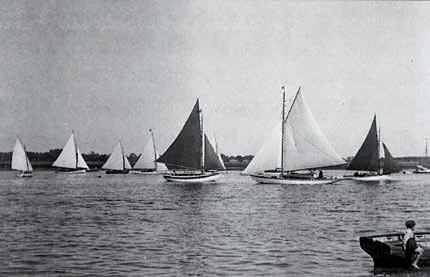
was held as to the length of the race, while one of the moored boats in the Ramsholt reach were o en used as turning marks. Di culties would occur for the slower boats in the eet when the turning mark sailed away. Later on xed marks were laid and set courses were adopted and racing became more organised and regulated.
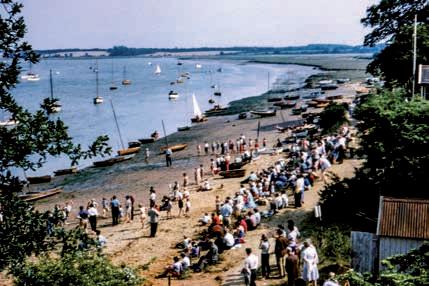
In the early years Club racing was largely keelboat and various non-class dinghies, but the adoption of National 12s in 1936 introduced one-design racing. e club developed quickly and by 1937 had passed 100 members.
In 1936 Cyril Stollery and Kenneth Palmer became the Club’s rst national champions a er winning the rst ever National 12 Burton Cup, held in Poole, in Itch N 153. During the 85 years since, the club produced some 42 national
13 INTRODUCTION – A CENTURY OF SAILING
Above: Waldringfield Regatta in the 1930s
Below: Shore activities during the Waldringfield Regatta in 1959 (John Palmer collection)
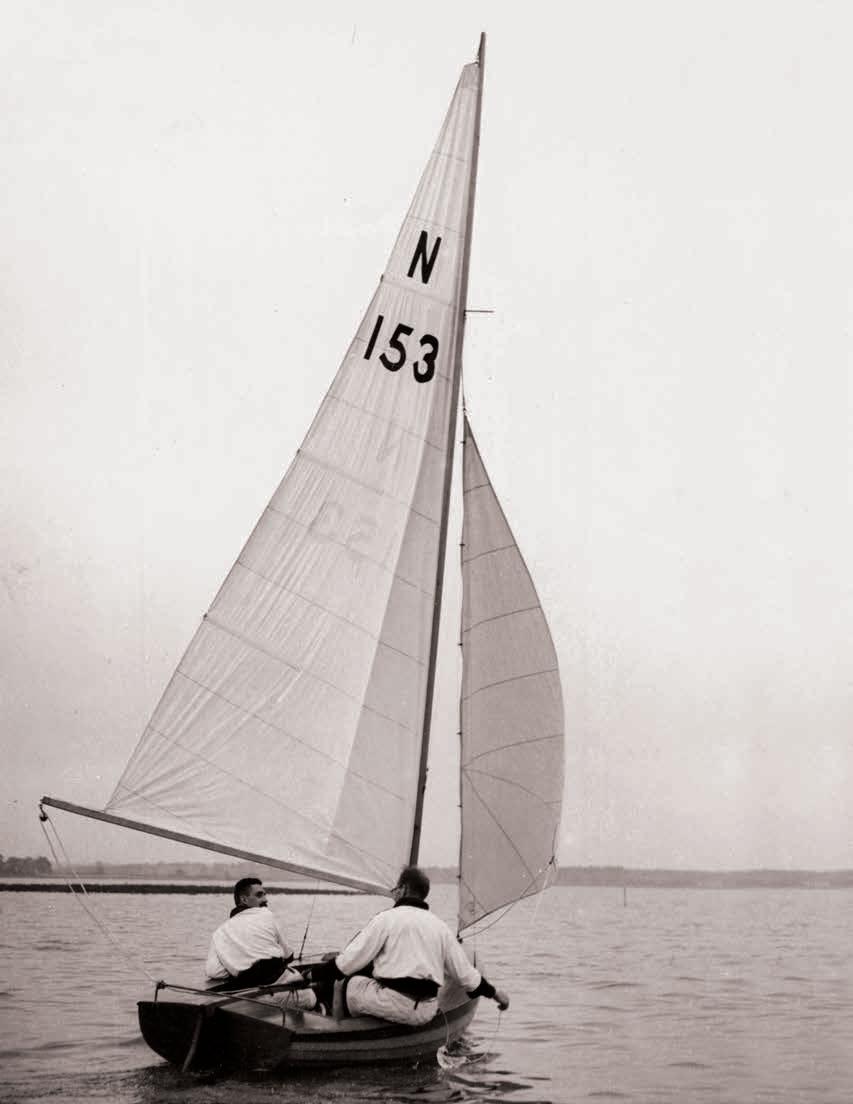
III
Between the Wars 1921 to 1939
Towards the end of the nineteenth century, and before Waldring eld Sailing Club was even imagined, many barges could be seen in the Waldring eld anchorage with other cra such as billyboys, snows, ketches and schooners, waiting to load or unload at the Quay or on the beach. e River Deben was a commercial thoroughfare for tra c to and from other ports on the east coast.
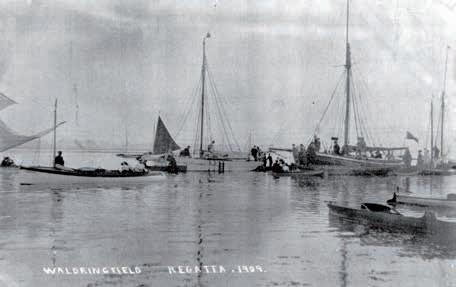
During the latter half of the nineteenth century the boats would carry manure, bricks and timber up the Deben and take away hay, straw and coprolite. When the Cement Works opened in the 1870s, the barges brought chalk and coal or coke to Waldring eld and were then loaded with cement. e barges would be piloted into the river at Felixstowe Ferry and then made their way up to Waldring eld where they would wait for the pilots to take them to Woodbridge or even as far as Wilford Bridge.
A er the coprolite industry closed in the nal decade of the nineteenth century, and then the Cement Works closed down and moved to Claydon in 1907, yachts began to take the place of the barges in the Waldring eld reach. While the river was mainly used for industry, there were of course some leisure activities taking place, but it wasn’t until the industrial closures that it started to become more commonplace and organised.
e island as it is today did not build up until the war, as the barge tra c used to keep the channel clear. e Woodbridge Pilots were at this time responsible for marking the channel with beacons. ere are records of the Woodbridge and Waldring eld Regatta taking place as
















31
D
C E W Y
Waldringfield in about 1923. On the left, Ernie Nunn is rowing his own una gig (John Palmer collection)
early as 1873. rough the early years of the twentieth century, maybe from 1906, the annual Waldring eld Regatta became more established and soon became a highlight of the summer when families would ock to Waldring eld for holidays. Many of the prominent families in the history of Waldring eld Sailing Club were rst introduced to the river and the village during summer holiday stays.
A boat yard was established at Waldring eld in 1921 with Harry Nunn setting up in business at a workshop on a plot of land adjacent to the Quay.
With the annual regattas creating such interest and participation, an increasing number of pleasure boats based on the river, and then the establishment of the boatyard, by the early 1920s everything was ripe for the development of more organised sailing activities. So it was that in the
spring of 1921, a few keen sailors met at Alfred Stollery’s Gorse Cabin on the Waldring eld foreshore to form a sailing club for the village. e rst Minute Book of the Club documents that Cli ord Paterson was elected as the President, Mr Albert Henry ‘Harry’ Nunn as the Secretary, and omas Naunton Waller as the Treasurer. e Executive Committee consisted of Alfred Stollery in the Chair, the Secretary, Treasurer, Arthur Quantrill, Bob Button Jnr. and Charles Rix. It was an eclectic group of people.
CLIFFORD PATERSON (1878-1948), later Sir Cli ord Paterson OBE FRS, was a renowned scientist, especially in the eld of illumination, and was awarded an OBE in 1916 for his work on the Paterson-Walsh aircra height nder. He was elected a fellow of the Royal Society in 1942 and knighted in 1946. He was Director of the General Electric Company Research Laboratories at Wembley – later named the Hirst Research Centre – from its foundation in 1919 until his death in 1948. e Cli ord Paterson Lecture prize lecture is still awarded biannually in his honour by the Royal Society.
His wife, Eleanor Daisy Ogden, introduced him to Waldring eld and they would spend holidays there, owning and racing the 1922 ga cutter, Clytie, which is still sailed on the Deben by Paterson’s descendents. Daisy kept a detailed diary of Clytie’s voyages and races, excerpts of which are included later.

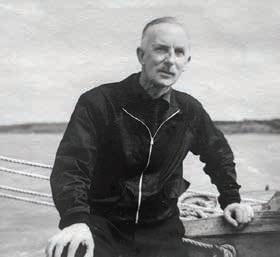
Cli ord Paterson also kept a war diary from the beginning of September 1939 until May 1945, which was later published as ‘A Scientist’s War’. He would remain as the Club’s President until 1929 when the position was changed to Commodore, for which he stood for one year before stepping down.
First President and Commodore Clifford Paterson at the helm of Clytie (Jo Masters Collection)
ALFRED WILLIAM STOLLERY, commonly known just as AW, is arguably the most important person in the history of the Club. It was probably on his initiative that this select group met in his hut at Gorse Cabin in 1921 to begin building the Club, though that is just speculation. He would go on to become the longest serving o cer in Club history, serving the Club for 33 years, initially as the chairman of the general committee, and including 28 as
32 A CENTURY OF SAILING – WALDRINGFIELD SAILING CLUB 1921-2021
a ag o cer, rstly Vice Commodore from 1927-1928, Commodore from 1930 to 1947 and nally Patron from 1950 until his death in 1959.
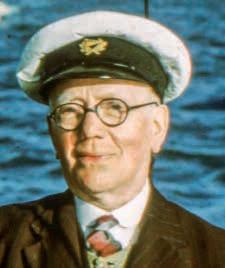
Alfred Stollery (1878-1959) was the ninth child of Eliza and Isaac Stollery. Isaac, who ran the ferry between Waldring eld and Stonner Point on the opposite shore, died aged 45 in 1880 leaving 11 children, the oldest being Arthur, who was born in 1861. Arthur was also a driving force in the early days of the Club. It is likely that Alfred’s son Cyril, was also, if not at that rst meeting – he was just 16 years old then – certainly involved very soon a er. e Church and the Waller family helped Eliza to cope with her family by setting up a shop for her so that she had an income. e Waller family also took in the older girls for service at the rectory. Alfred Stollery was grateful to the Wallers for this kindness, as losing his father at the age of ve must have made a big impression. e families became friends and that relationship grew such that he became involved in the Church both in Waldring eld and when he le for Surrey, playing the organ, and forming choirs. He later became a Parochial Lay Reader in the Church of England and a Diocesan Reader and acted as the Bishop’s chaplain on several occasions.
Another event that must also have made a big impression on him was the capsize of the 18 sailing boat in which his aunt and their family set out from Kirton Creek for a trip out to sea and back in a gentle breeze. Opposite Falkenham Creek, Able Seaman George climbed the mast to release the ag that had got caught in the rigging and the boat capsized. Alfred was involved in rescue, but his aunt and three family members out of the party of 11 died.
Alfred moved to, and settled in, West By eet, Surrey, where he ran an upholstery company and became a pillar of the community, serving on the Council for many years. His obituary in 1959 read ‘A man who was devoted to the welfare of the community.’ Despite moving to Surrey he kept links with Waldring eld, where the family leased a parcel of land behind the foreshore that was known as Gorse Cabin. He also later bought the Quay a er the Cement Works closed and leased it to Harry Nunn for his boatbuilding business. e Quay is still
owned by the Stollery family.
Alfred Stollery was perhaps more of an organiser than a racing sailor, and there is no doubt that the success of the Club in the early years was down to his energy, enthusiasm and administration skills, as well as signi cant nancial contributions over the years.
ALBERT HENRY ‘HARRY’ Nunn (18941976) was the son of a shepherd and born in Waldring eld. In 1921 he had been in business as H Nunn Boat Builder for just two years. It is said he was something of a perfectionist and everything had to be done properly. e company later became the famous Nunn Brothers, when his younger brother, Ernie, joined the business, and in 1928 the workshop
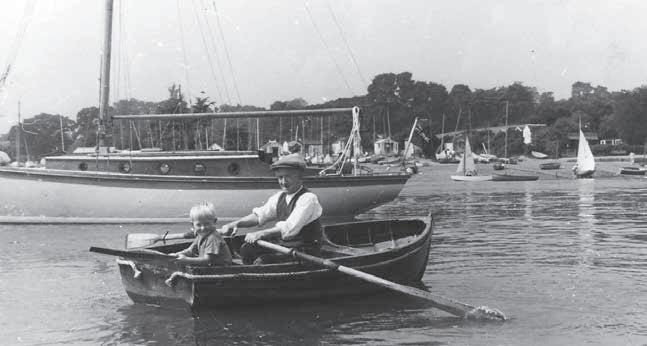
Second Commodore, and then later Patron, Alfred William Stollery (John Palmer Collection)
The Club’s first Secretary, Harry Nunn, in later years (Waldringfield History Group/Mike Nunn)
33 BETWEEN THE WARS – 1921-1939

VThe Clubhouse
The Waldring eld Sailing Club clubhouse is the main focus for Club activities and the gathering place for members to enjoy the company of fellow sailors. Its perfect location at the mid-point along the beach provides expansive and unobstructed views of the river from the Rocks up to Methergate. Its history is one of multiple extensions, rebuilds and improvements as it was gradually developed to keep pace with the growing membership



With the exception of the original clubhouse, each part of the building was formed around an earlier existing construction to form a kind of jigsaw of design, with all the parts tting together from the di erent eras in the history of the club. Only once in 100 years was the whole clubhouse built as a single project and that was for the rst purpose built clubhouse in 1932.
Ever since then, designers and architects have worked around that initial footprint and building, extending it here, rebuilding it there, while leaving much of the original concept in place for a long time.







A clubroom was added to the north side in 1949 and it was the deterioration of that which prompted the discussions in the late 1970s about re-building. e new entrance hall, crows nest, enlarged Ladies Changing Room, and gear shed were a later addition to the major works carried out in 1981. e original purpose built building from 1932 largely remained part of the club structure until these were completed in 1989.

e development of the clubhouse was also closely linked to the tenancy agreements and car park leases and that is described in a separate chapter.






Opposite: The Waldringfield Sailing Club clubhouse in the early 1950s with Gorse Cabin just visible to the left (John Palmer collection)
Below: The first purpose built clubhouse in 1932 (Mike Nunn archive)
93
D C E W Y
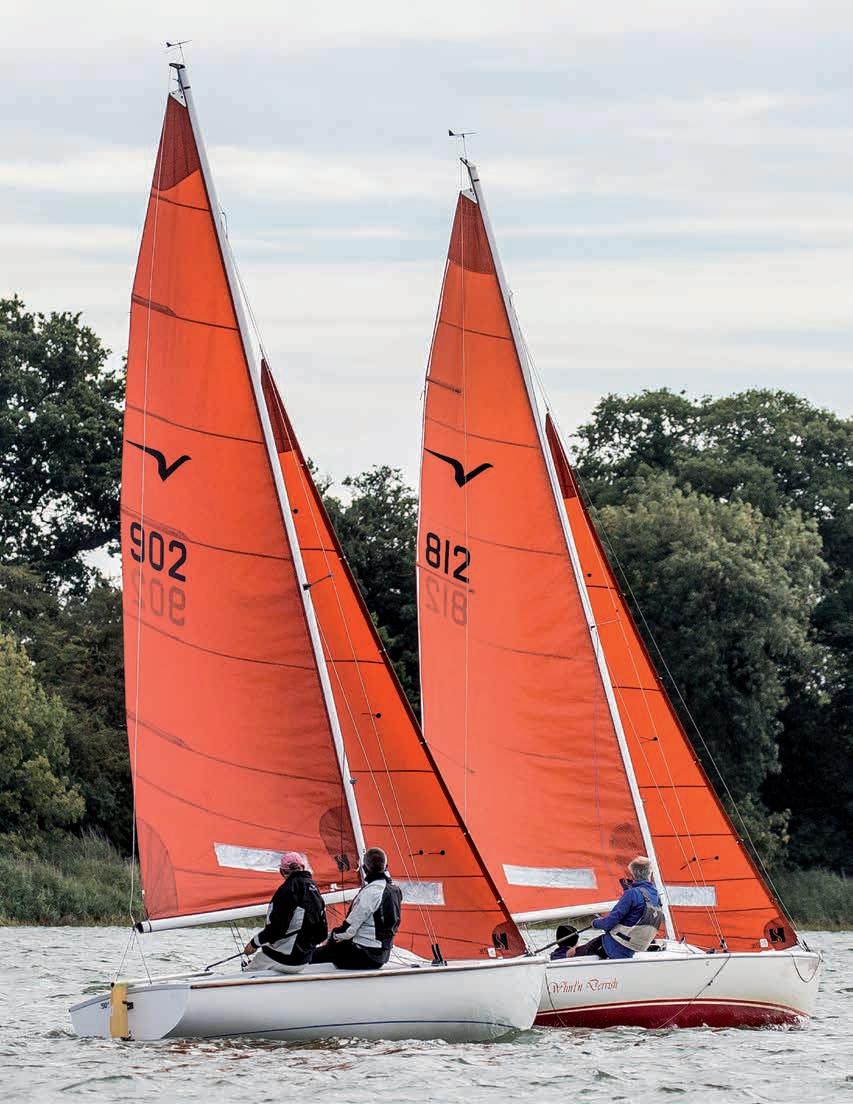
Fifty years of Squibbing
IN THE BEGINNING . . . On 30 May 1970 the first meeting of the Waldringfield Sailing Club Squib fleet was held. From the Minutes, “The meeting was opened by the Commodore Mr John Young, who indicated that the Club was prepared to adopt the Squib as a separate Club Class and suggested the election of a Captain and a Secretary. Proposed by Mike Spear and seconded by Terry Vernon that Dr Palmer be elected Captain - carried unanimously. Proposed by Chris Thompson and seconded by John Gilmour that Anthony Mason be elected Secretary – carried unanimously.”
The meeting went on to setting the pattern of Squib sailing for the next 50 years. It decided the number of races (decided to have as many as the Dragon class), whether or not to race on Wednesday and Friday evenings (not in 1970), courses, a Cup, setting up a mooring trot, cruises, interclub racing and to adopt the Owner’s Association rules (noting these stated no burnishing or polishing of antifouling). The meeting closed with “thanks to Terry and Stella Vernon for the use of their house (and their drinks)”.
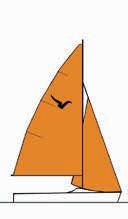
e WSC Club Yearbook for 1970 gives:
37. Kerfuffle Mr Gilmour
72. Guy Fawkes M Spear and T Vernon 90. Paramour A Mason
91. Discord Mr ompson
93. Sannu Dr Palmer (renamed Harmony)
Some boats came complete from the Oliver Lee yard but number 90 was a kit of mouldings with an unattached keel as bought by Anthony and Ann Mason. eir garden at Shottisham had a convenient tree from which to hoist the mouldings in the air whilst a trench was dug to accommodate the keel. e mouldings were lowered onto the keel and a Squib was born.
ONE OF THE rst Waldring eld Squibs was owned by John and Gillian Shambrook: “We purchased our Squib 72, Guy Fawkes, from joint owners Mike Spear and Terry Vernon and entered her regularly in the Club Saturday races.
902 and 812 Whirl’n Dervish enjoy a close start in 2018 (Robert Deaves)
105
VI

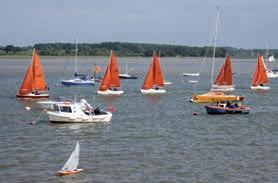

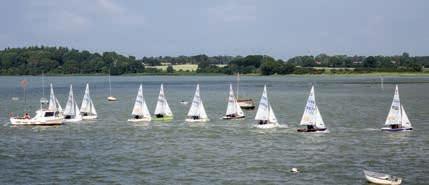
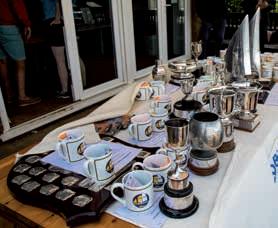

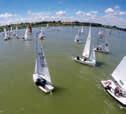
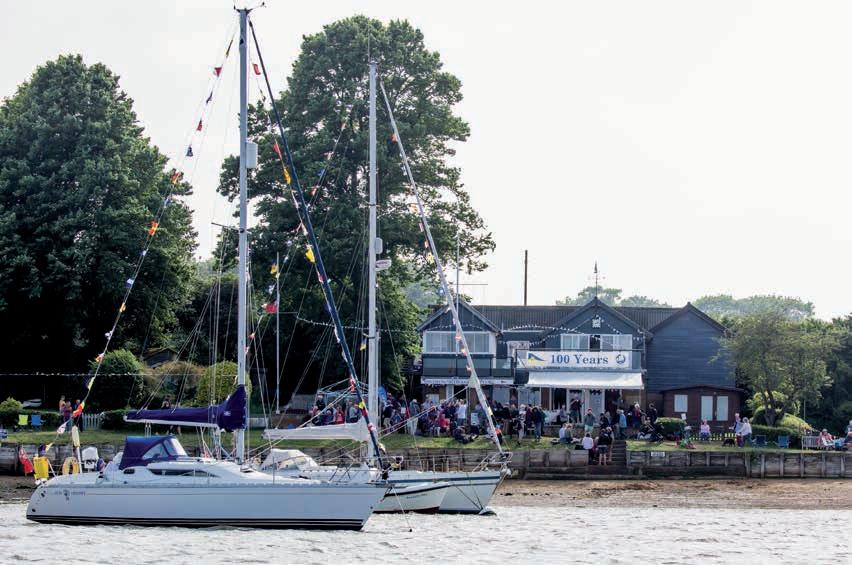

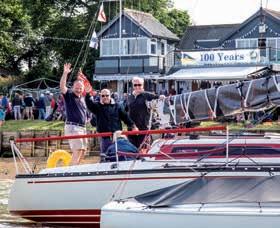
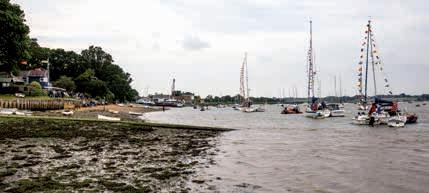
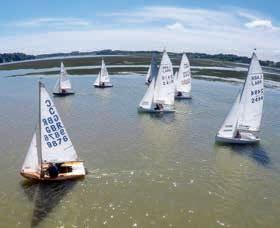

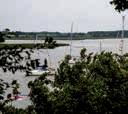
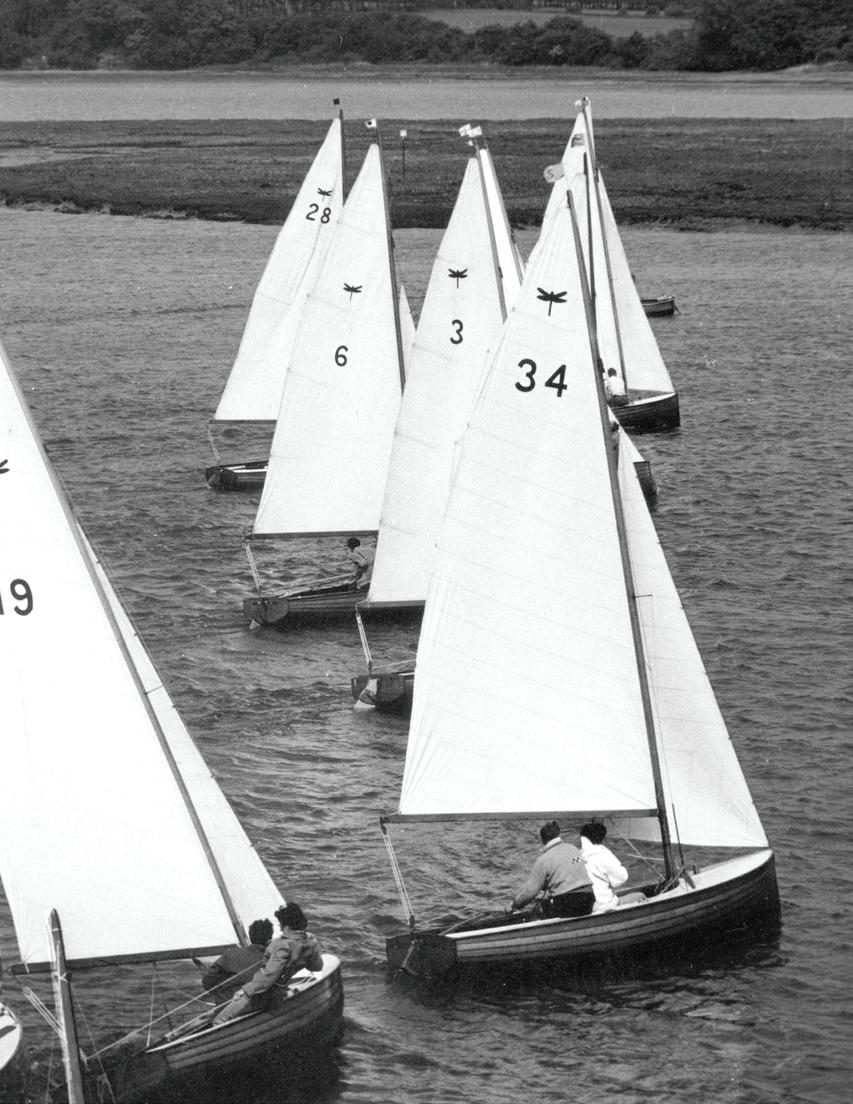
The Waldringfield Dragonfly
In the immediate years a er World War II, a need was felt within the club to adopt a new class for one design racing. It was discussed several times before the war, and various eets of di erent types of 12 dinghies came and went, but nothing stuck. However the subject was again broached in 1946 by none other than Cyril Stollery and led to the development and introduction of the inimitable Waldring eld Dragon y.
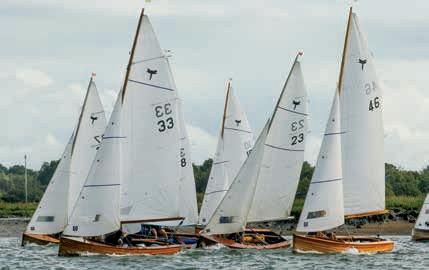












It was the beginning of a movement that continues to this day, with around 13 Dragon ies still on the water at Waldring eld out of the 44 that were built. For decades it produced the best racing at Waldring eld with cutthroat competition for bragging rights. Most of the best Club helms from the 1950s to the 1970s came through the Dragon y class, pitting their wits and skills against each other for some of the best trophies the Club has to o er. ese days the boat still o ers a challenge to a new generation of enthusiasts, who lovingly maintain the last vestiges of the Club’s heritage from the post war years.
ONE-DESIGN RACING
Class dinghy racing before 1939 was largely con ned to the International and National classes. A er World War II the informal talk at the Club was of a class comparable in size to the 14’ International with speed to match that of the 12’ National and a beam su cient to take the family – or ‘grandmother’ according to Ernie Nunn –sailing on Sundays.

e earliest reference to the formation of what was to become the Waldring eld Dragon y Class appears in the general committee minutes from a meeting on 17 August 1946. A letter was read from Cyril Stollery, who was not in attendance,
Opposite: A start in the 1950s (Club archive)
Below: Club racing in 2020 (Alexis Smith)
123
V
an article appeared about the new boat, which stated that the control of this one-design class was in the hands of the Waldring eld Dragon y Committee. In the August number a letter from the Commodore of the Christchurch Sailing Club was published. He referred to the fact that his Club had ordered six of the boats and hoped that in the near future a successful one-design class would materialise. It was to be called the Christchurch Dragon y Class, a decision made in consultation with the designer. He went on to say, ‘I have been informed by Mr Kennedy that the Waldring eld Dragon y Committee have control of the design only in the Counties of Norfolk, Su olk and Essex and accordingly it should be made clear that we do not consider ourselves tied to the direction of any other Club.’ e following month, a reply from Cyril Stollery, Vice Commodore, was published. He was sure that the Commodore of the Christchurch Sailing Club wrote under a misapprehension. ‘ e Waldring eld Sailing Club have no desire to control his class, but they did hope that they might be allowed the exclusive use of the name Dragon y which they chose and applied to their own class.’ He went on – ‘Mr. Kennedy’s request for permission to use the name ‘Dragon y’ was not granted for reasons that would take too long to detail here, but which surround the intention to make a very strict one-design class with some unusual provisions calculated to reduce costs and make for ease of maintenance. e Waldring eld Sailing Club will be pleased to co-operate with any Club for national numbering provided that similar rules can be agreed.’
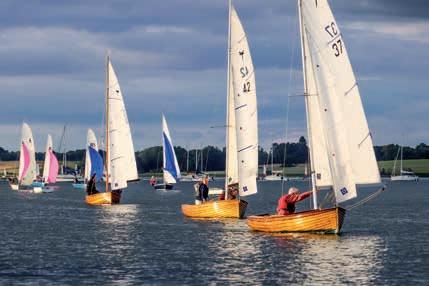
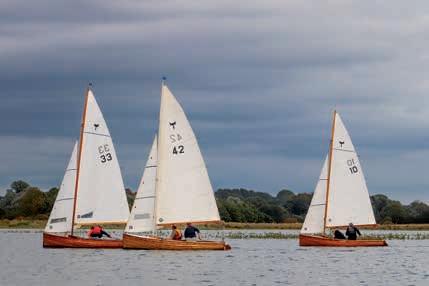
October 1948 must have been an exciting, but frustrating month. On 1 October, the Secretary con rmed acceptance to the designer, but said that the a decking, which the designer had suggested, was not required. e proposed stern decking was probably rejected because it made leaping aboard more di cult when leaving the beach and also inhibited access to the a er end of the boom when under way. e designer was slow in producing tracings of the modi cations to the drawings. He enquired and was told that the centreplate was to be of wood, one working jib only was required, no spinnaker or boom was needed, the mast was to be stepped at deck
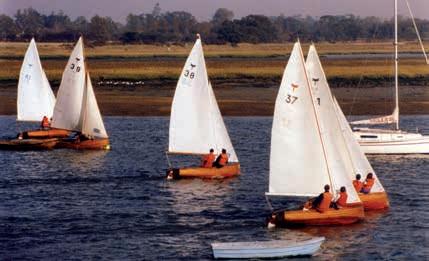
130 A CENTURY OF SAILING – WALDRINGFIELD SAILING CLUB 1921-2021
Top: Racing in 1985 (Robert Deaves)
Middle, bottom and opposite top: Racing in 2019-2021 (Alexis Smith)
level and that a Birma-bright metal rudder blade was to be tted.

On 26 October, when the General Committee next met, it was reported that ‘certain members’ were concerned at rumours that the design was to be considerably altered and Mr Nunn is recorded in the Minutes as saying that he and Mr Robertson felt they had been treated ‘very shabbily’ in not yet having the plans available. Happily the Hon. Secretary was able to refer to the designer’s letter of 14 September and make clear that the alterations were being carried out by the designer at his own suggestion to bring the boats into line with his current ideas and the meeting resolved that the Secretary should telephone the designer and ask him to expedite delivery of the plans. In fact the Secretary wrote a letter two days later and received an immediate apology from the designer, pleading pressure of work.
BUILDING
At the end of the rst week of November 1948, the working drawings eventually began to arrive. Ernie Nunn made the moulds both for himself and for Robertsons so as to ensure that identical boats were built at the two boatyards. During the winter of 1948-49, on the initiative of Ernie Nunn, the partly built skeleton of a Dragon y was taken into Ipswich, to the Great White Horse Hotel, and was hoisted up the outside of the building and through a window to the room on the rst oor in which the Club were holding their dinner dance and was exhibited there for the bene t of the members and their guests.
e Dragon y Class Committee held its rst meeting on 3 April 1949, when the construction of the boats was su ciently far advanced to decide the ‘draw’ for the boats would take place at the Annual General Meeting on 16 April, when Mr and Mrs Spear were to o ciate. e instruction to the boat builders to cut the sail numbers in the transom of the boats was given.
e boats cost £152.10s.0d each, which was one and a half times an average working man’s annual wage at the time. e draw duly took place on 16 April 1949 and the rst owners of the rst Dragon ies were:
Dennis Moore (No 1, Moppett); L E Ogden (No 2, Fantee); A A Gibbons (No 3, Snap); Paul King (No 4, Temper); Geo A Revett (No 5, Wings);

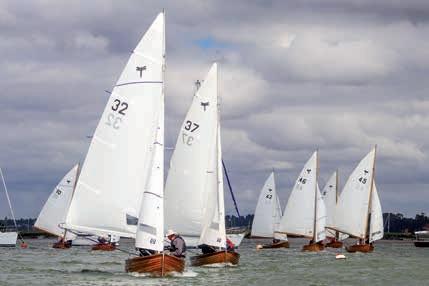
The original Rule 2(d) stated ‘Every owner shall fly when racing a racing flag.’ The shields shown here represent the flags that were flown by the owners in the early days of the class. These shields used to adorn the clubroom, but are now displayed in the Mossman Room.

















131 THE WALDRINGFIELD DRAGONFLY
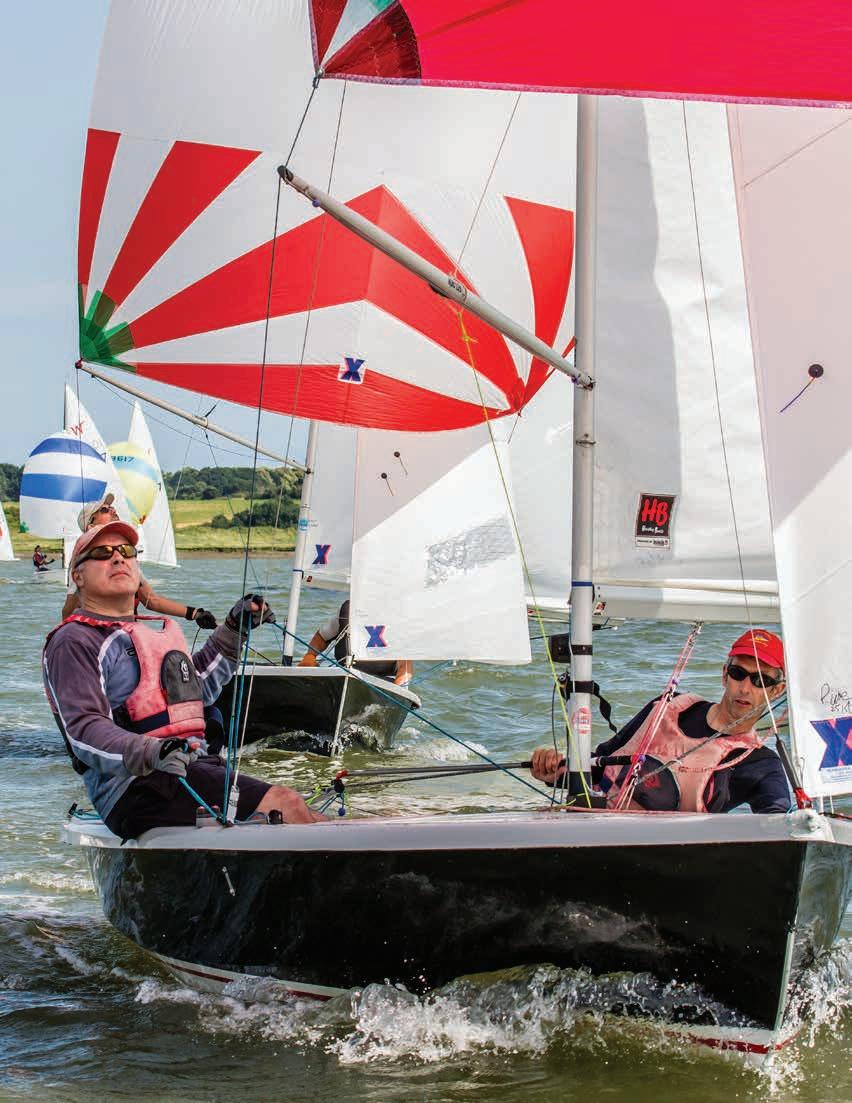
The Wayfarers
Wayfarers have been an active class at the Club since the 1970s. Initially the numbers were small but were swelled by some Dragon y owning members who had become weary of the constant care or cost of keeping the traditional construction wooden boats in good condition. It was time for a champion for the class to step forward and Rosemary Schlee was the person who encouraged others to join in, ordering six new boats from Moore’s of Wroxham. e wrecking of Charlie Taylor’s Dragon y on the Deben Bar in 1979 was to be one of the events that in uenced the birth of the Wayfarer class as he needed a new boat to race. e six new boats included his MkII breglass boat, Zeus, with a yellow hull and blue deck in the Club colours.
Several new members joined from Deben Yacht Club as there was a bigger eet at Waldring eld and they were attracted by the regular sailing times. Brian Johnson, and his son Colin, and granddaughter Clare, were early arrivals together with Jonathan Christie, Mike Oldroyd, Don Suskins, Terry Box, Peter Cro s and others who came to join frequent racers including John Hammond, Guy Hacon and Mike Pert.
Rosemary’s fervour and zeal were such that when she heard there were boats at Deben Yacht Club, she arranged a small drinks party at the Maybush, with existing Wayfarer members including Charlie Taylor and his crew Graham Mills, Charles Brooke-Smith, Guy Hacon, David and Angela Mace to persuade others to join WSC. It was a master stroke and the group gladly ‘jumped ship’ from Deben YC. Other past wayfarer sailors included Mike Arnold, Roger Cooke and Paul Brigginshaw.
WOpposite: Neil Fletcher and Chas Edwards in Wind’s Song in 2017 (Robert Deaves)
Below: Rosemary Schlee was the driving force to get the Wayfarer class adopted by the Club in 1980, and was just as determined on the water (Chris Baker)
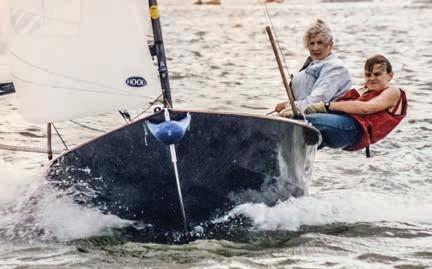
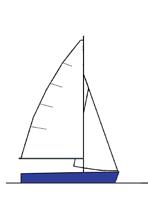
263
xx
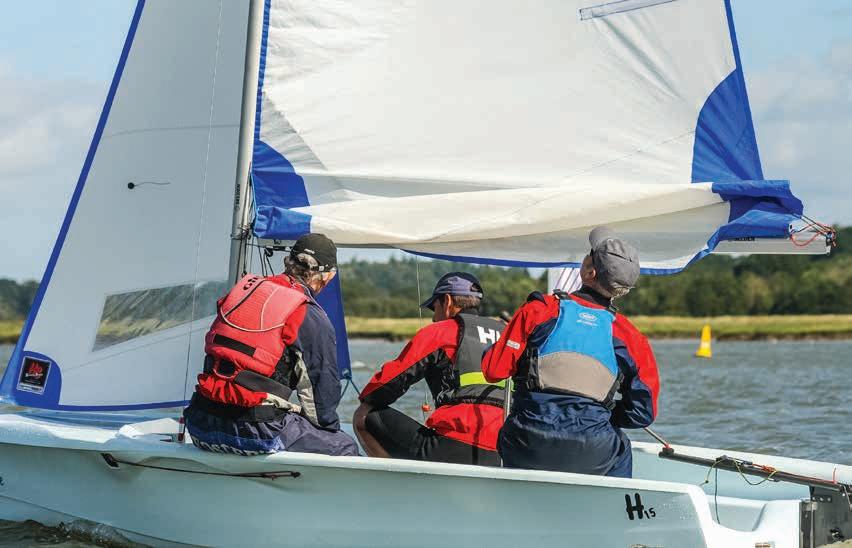
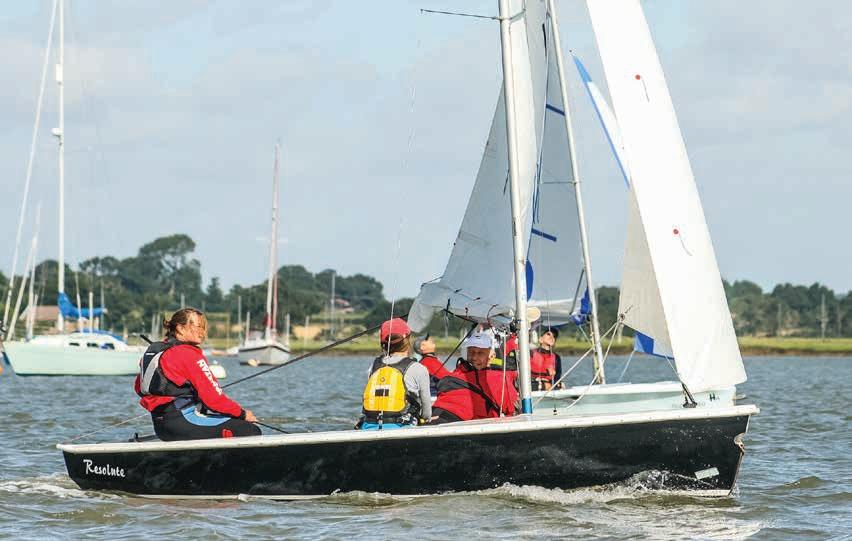
xx
A very brief history of sailing courses
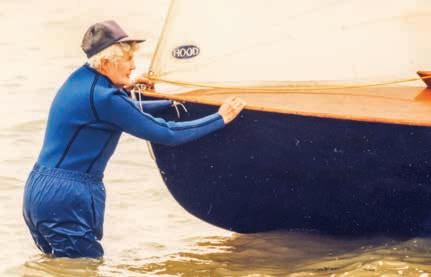











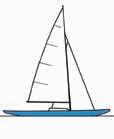
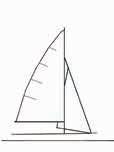

Beginner sail training, as distinct from race training, has a long and not wholly distinguished history at Waldring eld. In the early 1980s Rosemary Schlee started running a 5-day RYA summer holiday course, with a lot of help from Joan Mossman and Ann Mason and scores of others, entirely as a fund raiser for the new clubhouse. It was hard work, using generously lent adult boats of all shapes and sizes, with unquali ed and unpaid helpers. All the boats were on moorings, and getting them sorted before and a er the course, and returning them to the owners unscathed, or repaired, was the stu of mild nightmares. When phoning the list of owners in about June, and there was o en a sort of silence at the end of the line… ere were no junior boats, no RIBS, and children were put in Wayfarers where their feet barely touched the oor.
A er Rosemary came Norman Landon, who ran a sail training week, with no RYA structure and still using borrowed boats. About that time most of the Wayfarers at the club became rather smart and not suitable, or available, for borrowing. Racing boats don’t reef down and no-one wants beginners doing capsizing practice in their pride and joy and grinding to a halt on the slipway.
en in the 1990s came John Laws, and it was back following RYA course structures. e Club ran a half term course and a summer course, and started to hire the RYA mobile eets with a lot of Toppers and Optimists. Getting these from the road to the dinghy park was a mammoth task. Roger Cooke and Graham Mills and many, many others helped out, including the late and great Brenda Canham, who was the person picking up the many pieces.
A er John came Brendan McArdle, helped by Roger Cooke, and still using hire eets that
Opposite
Top: Redoubtable, a Hartley 15
Bottom: Resolute, one of the original Wayfarers
Below: Rosemary Schlee started the training courses to raise funds for the new Clubhouse (Alexis Smith)
221
D C E W Y

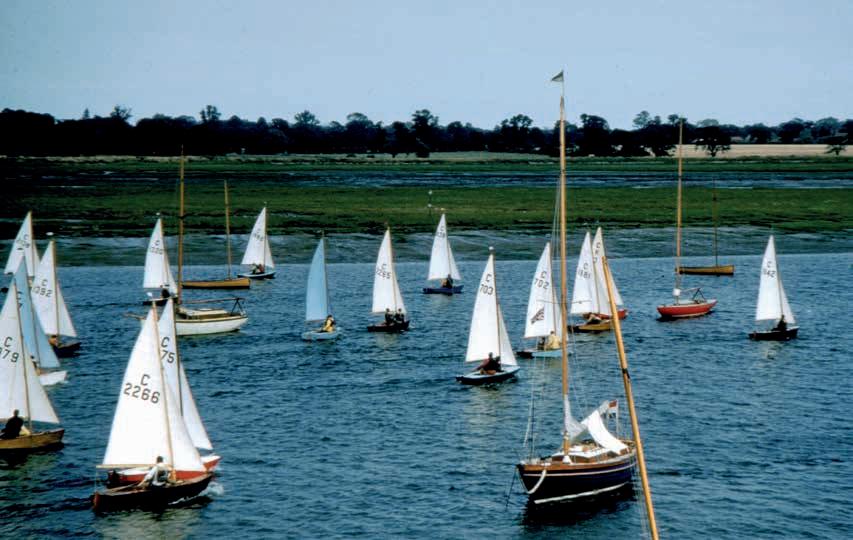
xx Cadet Squadron 35
The Cadet is synonymous with Waldring eld, being one of the oldest classes still sailed at the Club. At several times the Club had one of the largest and strongest Cadet squadrons in the country with Club members picking up eight national titles over the years as well as two world championships.
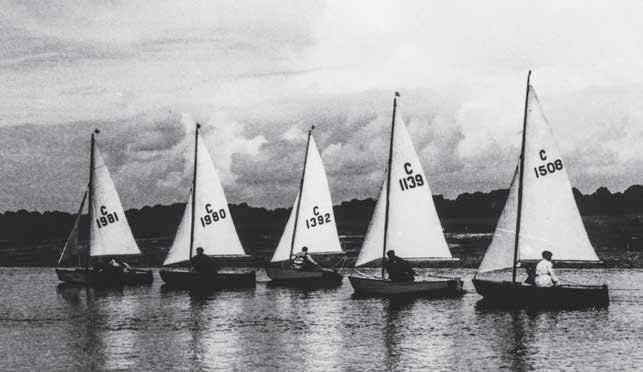
e Cadet Dinghy was designed in 1947 by the legendary Jack Holt as a boat that could be built at home from plywood on a limited budget. e boat was developed to allow children to participate in dinghy sailing, since at the same time several new classes were being designed that introduced many new adults to start participating in the sport of sailing in the post-war period. Crews generally start sailing in Cadets aged 8-9 years old and then start helming by the age of 12-13 but this can vary depending on a child’s experience and size. e class has a maximum age of 17 for competing in events.
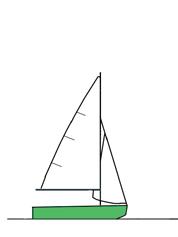
FALSE START
Cadets are rst mentioned in the Club’s minute books on 8 April 1950 at the Annual General Meeting. ose minutes read: “ e Vice Commodore (Mr EA Wilde) referred to the need for o ering junior members a more comprehensive and methodical course of instruction and said that a committee formed to consider the matter was of the opinion that if they had a class of boat for youngsters it would solve the di culty. It was nally decided to choose the ‘Yachting World Cadet’. Six boats of this type had already been nished, two had
225
C

xx
Racing at Waldringfield
Racing has always been the priority for Waldring eld Sailing Club, with the membership several times resisting pressure to become more of a social yacht club. Since the early 1950s it has also been focussed on one-design racing for its main points series, with handicap racing limited to evening racing and the occasional all-comers race.
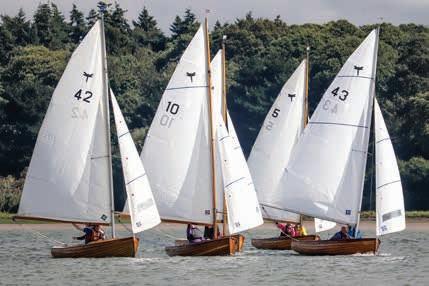
Over the rst 100 years of the Club there have been class starts for a range of mixed boat eets and one-design classes. Until sometime in the mid-1930s there was just one class start, but then more were added as numbers grew, and members wanted to race di erent types of boats. e racing was then initially organised in A, B, C and D starts and the classes attached to each letter would change year to year presumably to keep pace with the changing pattern of boats owned by members at the Club. At the beginning there were no one-design classes, so all class starts were determined by a subset of the boats within the Club. Only a er 1949 did they begin to evolve into speci c one-design class starts.
FROM A TO G
‘A Class’ was always yachts, but the de nition would change as the years passed. Initially there was no de nition, then it became boats over 16 in 1949, over 14 in 1950, keel or cabin boats over 19 in the 1960s, and then over 16 in the 1970s before reverting back to just yachts.
‘B Class’ was at various times dinghies under 17 , dinghies under 16 and dinghies under 14 . When these boats dwindled in number, the ‘B Class’ was used for Enterprises and later still OK Dinghies.
‘C Class’ began as dinghies of 12 and under,














267
D
E
Y
C
W
It is interesting to note the development of the fleets and how the definitions of Classes changed over the years. These are taken from the annual Club programmes.
1939
A – Yachts
B – 16ft & under, including 12 ft NR
Class Dinghys
C – 12ft & under, including RAF 10ft OD Dinghys
1947
A – Yachts
B – Dinghies, 16ft & under
C – 12ft National and Restricted Classes
D – Dinghies, 12ft & under, including RAF 10ft OD
1949 (Class Code Flags A, B, D, respectively)
1 – Yachts (to include boats over 16ft)
2 – Dinghies, 16ft & under
3 – Dragonflies
1950
1 – Yachts (to include boats over 14ft)
2 – Dinghies, 14ft & under
3 – Cadets
4 – Dragonflies
1951
1 – Yachts (to include boats over 20ft)
2 – Dinghies, 20ft & under
3 – Cadets
4 – Dragonflies
1952 (Class Code Flags A, B, C, D, E, respectively)
1 – Yachts (to include boats over 17ft)
2 – Dinghies, 17ft & under
3 – Cadets
4 – Dragonflies
5 – National 12’s and Fireflies
1954 (Class Code Flags A, B, D, E, respectively)
A – Yachts (to include boats over 19ft)
B – Dinghies, 19ft & under D – Dragonflies
E – National 12’s and Fireflies
1957
A – Yachts (to include all keel boats over 19ft or others at the discretion of the Yacht Committee)
B – Dinghies, 19ft & under C – YW Cadets
D – Dragonflies
E – National 12’s and Fireflies
1958
A (1)– Yachts to include all keel and/ or cabin boats 19ft and over (overall length) for which a satisfactory rating based on RYA rules can be determined.
A (2) – Dragons (Class Flag F)
B – Dinghies, 19ft & under C – YW Cadets
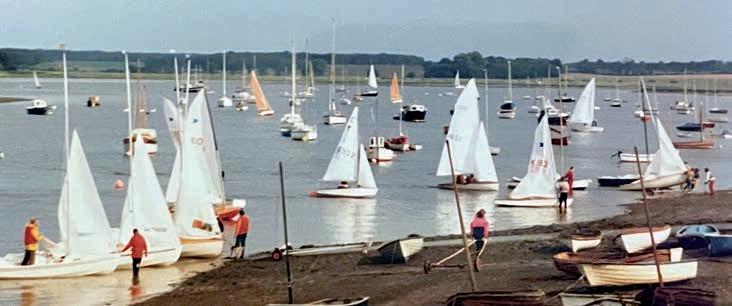
D – Dragonflies
E – National 12’s and Fireflies
1960
A (1)– Yachts to include all keel and/ or cabin boats 19ft and over (overall
length) for which a satisfactory rating based on RYA rules can be determined.
Code Flag A
A (2) – Dragons. Class Flag D
B – Enterprises. Code Flag E
C – YW Cadets. Code Flag Y D – Dragonflies. Code Flag W
E – National 12’s and Fireflies. Code Flags T and F.
1966
A (1)– Yachts to include all keel and/ or cabin boats 19ft and over (overall length) for which a satisfactory rating based on RYA rules can be determined.
Code Flag A
B – Enterprises. Code Flag E
C – International Cadets. Code Flag Y D – Dragonflies. Code Flag W
E – National Fireflies. Code Flags F. F – OK Dinghies. OK Insignia
1972
A (1)– Yachts to include all keel and/ or cabin boats 19ft and over (overall length) for which a satisfactory rating based on RYA rules can be determined.
Code Flag
B – OK Dinghies. Code Flag OK Insignia C – International Cadets. Code Flag Y D – Dragonflies. Code Flag W
E – International Enterprises. Code Flag E F – National Squibs. Code Flag Z G – International Dragons. Code Flags D.
In later years classes only appeared in the racing programme table.
268 A CENTURY OF SAILING – WALDRINGFIELD SAILING CLUB 1921-2021
later 12 Nationals and Bermudian rigged 12 dinghies, then one year for Dragon ies, but then came to be used for the Cadet class when that was rst adopted in 1949.
‘D Class’ was also used for dinghies of 12 and under including the RAF 10 One Design, before being used for Dragon ies.
By the early 1970s there were Class start designations from A to G including Yachts over 16 , OK Dinghies, Cadets, Dragon ies, Enterprises, Squibs and Dragons, but as the starting classes evolved to pure one-design classes, with the exception of yachts, the letters were dropped in the 1970s.
Over the years there have been about seven starts for mixed boat eets based on length and type, while since the mid-1960s when onedesigns started to become more popular there have been starts for 17 di erent classes.
In the immediate post war years there was demand for cheap one-design classes. When the Dragon y and Cadet were adopted in 1949, it
transformed the racing structure of the Club. en National 12s and Fire ies were added, somewhat strangely, as a single class racing. Dragons were adopted in 1958, with Enterprises following in 1960, and that was largely the end of general handicap racing at the Club.
OK Dinghies followed in 1965 and Squibs in 1970, while the Dragons struggled with numbers. e Fireball was adopted twice but on both occasions only lasted one year. e Laser was rst adopted in 1978 but was gone in a few years through lack of support, only to come back in good numbers in 1998. e Radial was split from the larger standard Laser in 2012, but they were soon sailed again as a single eet. e Wayfarer arrived in 1981, followed soon a er by the Lark in 1985, and both were considerably successful. When the Lark started to decline, the RS400 was adopted to try and attract the youth, but it was too large and fast for racing on the River Deben in numbers and was dropped a few years later.
269 RACING AT WALDRINGFIELD
1921 1930 1940 1950 1960 1970 1980 1990 2000 2010 2021 Yachts <16ft <12ft 12ft N and R <12ft Enterprises Cadet Dragonfly Firefly Dragon National 12 Squib OK Dinghy Laser Fireball Wayfarer Lark RS400 RS200 Topper Mirror K Start Wednesday evening Friday evening Easter Egg Cartoon Trophy Deben Week Cadet Week 1921 1930 1940 1950 1960 1970 1980 1990 2000 2010 2021 OK DINGHY 1965-1998 XXXX-XXXX ENTERPRISE 1960-1987 UNDER 16 ft UNDER 12 ft LARK 1985-PRESENT WAYFARER 1981-PRESENT SQUIB 1970-PRESENT DRAGON 1957 - 1983 DRAGONFLY 1958-PRESENT YACHTS 12 FT NATIONAL K LASER 1952-1960 UNDER 12 FT RS400 RS200 FIREFLIES 1952CADETS 1951-1953 AND 1957-PRESENT DEBEN WEEK 1947 - 2006 EASTER EGG REGATTA FRIDAY EVENING RACING WEDNESDAY EVENING RACING CARTOON TROPHY (ORIGINALLY OK DINGHY ONLY) UNDER 12FT LASER 1998/RADIAL 2012-PRESENT WORLD WAR II CADET WEEK 1957-PRESENT YACHTS Timeline of classes and regattas

































































































































































































































304
VV













Trophies and Winners
Waldring eld Sailing Club has a wealth of trophies and prizes dating back 100 years. e rst ever Club trophy was the Challenge Cup, presented by the then President, Cli ord Paterson, though it is now known as the Paterson Cup. is Cup has had a variety of uses but has not been presented since 2014. Only seven cups for points racing were presented before World War II: Paterson Cup (1922), e Palmer Cup (Kenneth Nicholls Palmer, 1930, replaced in 1936), Novices Cup (Cyril Stollery, 1932), Spear Challenge Cup (Donald Spear, 1934), 12 National Challenge Cup (Alfred Curjel, 1936), the Challenge Cherub Cup (Alfred Stollery, 1936) and the Ladies Cup (AF Hunt, 1938).
However, the biggest event of the year was the annual Waldring eld Regatta, and this attracted some of the biggest cups, o en presented by visitors to the event. e early cups included, for the rst day of the Regatta, the Stollery Cup (Alfred Stollery, 1924), Wickman Cup (Axel Wickman, 1929), Winn Challenge Cup (Miss Winn, 1930), the Hudson Cup (Mr Hudson, 1939), Cabin Cruisers (Alfred Stollery, 1932),
WSC Regatta Cup 18 & Under (1932). Second day trophies included the Cheru Challenge Cup (Alfred Stollery, 1936), the Mrs Wickman Cup (Mrs AC Wickman, 1934), and the famous Bradley Cup (Mr AW Bradley, 1930), probably the Club’s most valuable piece of silverware.











Many of the regatta cups are now used for Club racing and many of the details are unclear with many trophies being used for di erent purposes over the years. Disclaimer: In researching this chapter there were clear discrepancies on some cups dating back to the 1930s, with names missing, or large gaps, so it was not always clear what was the true list of winers or purposes. e following records represent the best attempt to records the winners of the Club’s principal trophies.
Notwisthstanding that, these cups are a direct and tangible link from the Club’s founders a century ago, and those who developed the Club, to the sailors of today. A record of all these early cups used to hang in the Clubhouse, but age and water damage makes it hard to read now. It covers all the early season points and regatta cups from 1922 up to 1950. ere are four cups for the rst day of the regatta, seven for the second day
Above: The first ever winner of the first ever Waldringfield Sailing Cup, the Paterson Cup, was Arthur W Quantril in Try Mee






Opposite: Some of the Club’s extensive collection




305
D C E W Y
This ‘Record of Cups and Winners’ was displayed in the Clubhouse for many years but later suffered from water damage and is no longer displayed. It includes all the early Regatta and Club points series cups, and they are all included on the following pages.

of the regatta and eight for the season’s points. Most are still in use and together they represent the remarkable heritage of the Club.
e rst trophy presented a er the war was the Victory Plate, given in 1945 by the ag o cers to commemorate VE day. Since the then the Club has been given a plethora of trophies and cups of all shapes and sizes. ere are now well over 200 with an estimated value of more than £25,000. e Club’s most valuable trophies include the Hardy Annual, the Humby Plate, Jubilee Cup and the Wickman Challenge. e smallest is probably the Ted Sudell Cup for Squibs, standing about four inches tall, while the largest, and most vauable would probably be the OK Dinghy Cartoon Trophy, an original cartoon by the famous cartoonist Carl Giles presented to the class in 1967. Several audits and valuations have taken place over the years.
e Jubilee Cup has arguably the greatest provenance of any in the collection. is is the original National 12 Championship trophy.
In 1936 Sir Wiliam Burton, who was from Ipswich and the President of the Yacht Racing Association, presented a silver cup to the National 12 class for the winner of the third race
in the national championship, from which Burton Week wook its name. Both were won by Cyril Stollery and Kenneth Palmer in N 153, Itch, and they were allowed to keep the trophies. In 1971, Cyril Stollery’s wife Frances, donated the Yachting World Points trophy, for the overall winner, to the club and it was called the Jubilee Cup and awarded to the rst keelboat in the Victory Plate race. Sir Wiliam Burton presented another trophy to the National 12 class, the current Burton Cup, which has been raced for ever since and won by WSC members on several occasions.
Nine of the old trophies are currently used for the Club Championship, a series of all comer races throughout the year to decide the best sailor of the season. Most trophies have a stated purpose and/or a preferred course and the Club tries to maintain the wishes of the original donors as much as the conditions, and weather will allow. Some have been competed for every year for the past 100 years, and many for more than 50 years. During that time people have come and gone, but many names have gone down in the history of the Club. Names such as Cyril Stollery, Kenneth Nicholls Palmer, Bob Garnham, Jem Goddard, George Turner, Dennis Mossman, Roy Webb, Ted Sudell, Jonty Sherwill, Anthony Mason and Gordon Harris litter the trophies through the decades.
To read these engravings is to see the history of the Club and to know that that many of the trophy winners of two or three generations ago have younger family members still competing for, and winning, these trophies. Some winners were juniors when they rst won and are still competing to win as adults.
e following pages include all the early pre-World War II trophies, along with the most important ones since, in chronological order for when they were presented.
306 A CENTURY OF SAILING – WALDRINGFIELD SAILING CLUB 1921-2021
THE CHALLENGE CUP, aka THE PATERSON CUP, 1922

In 1922, the first full year of racing, the first president, Clifford Paterson, donated a trophy for the Season’s Points. In 2002 it was reallocated to the first Shrimper in Deben Week. In 2007 it was reallocated to the Lark Open Meeting.

1922 Arthur Quantrill, Try Mee
1923 Alfred Curjel, Arc
1924 JGB Fairley, Lady Little Care 1925 Ernie Nunn, Half a Mo
1926 Cyril Stollery, One More
1927 Rev Trevor Waller, Theo 1928 Cyril Stollery, One More 1929 Axel Wickman, Prudence 1930 Axel Wickman, Prudence
1931 No record 1932 No record 1933 Cyril Stollery, St Patrick *

1934 Miss Poppy Orvis, Rainbow 1935 Cyril Stollery, St Patrick 1936 Miss Poppy Orvis, Rainbow
1937 Miss Poppy Orvis, Rainbow
1938 Bryan Hawkes, Eyas 1939-45 War 1946 Quin Parker, Ena 1947 T Digby, Jane 1948 T Digby, Jane
1949 G Alexander, Caprice 1950-2 Not awarded


1953 Dr Kenneth Nicholls-Palmer, Cormorant

1954 Dr Kenneth Nicholls-Palmer, Cormorant 1955 Richard Larkman, Item Smut 1956 Paul King, Flare



STOLLERY CUP, 1924
This is the oldest of the Regatta Cups and was first presented in 1924 for A Class yachts. In 1960 the cup was replaced by Cyril Stollery in memory of his father who had presented the original in 1924. In 1977 it was reallocated to Yachts B with the agreed with Mrs Frances Stollery. In 1998 re-allocated as Ladies Cup on WSC Trophy Day, but when the Ladies cup was found in 2002, it was recallocated again to the Yacht Class Timed challenge. In 2018 it was reallocated in recognition of the organiser of the London cruises













1924 JG Fairley, Lady Little Care 1925 Cyril Stollery, One More 1926 AJ Hayward, Isselle 1927 Axel Wickman, Lady Molly 1928 Cyril Stollery, One More 1929 Miss Constance Winn, Qinque 1930 Cyril Stollery, St Patrick 1931 Trevor Waller, Theo 1932 Axel Wickman, Prudence 1933 Cyril Stollery, St Patrick 1934 Cyril Stollery, St Patrick 1935 Miss Orvis, Rainbow 1936 F A Gooderham, Isselle 1937 Kennth Palmer, Terapin 1938 Miss Orvis, Rainbow 1939 J Venmore-Rowland, НаНа 1939-1945 War 1946 R Garnham, St George 1947 R Garnham, St George 1948 Richard Pershouse, Harkaway 1949 W Farguharson, Red Jacket 1950 F J Pearce, Diana 1951 AHN Waller, Hooghley 1952 LC Thomson, Green Dragon 1953 Alfred Curjel, Cherub 1954 AHN Waller, Hooghley 1955 W Prescott, Emerald 1956 Richard Pershouse, Harkaway
1957 AG Mason, Jam 1958 Richard Pershouse, Harkaway 1959 Cyril Stollery, Odin 1960 Сyril Stollery, Sandra
1957 P Simpson, Scherazade
1958 Richard Larkman, Item Smut
1959 A Howard, Emerald
1960 Kenneth Wincer, Maroli
1961 FJ Heath, Phaea
1962 FJ Heath, Phaea
1963 Tony Howard, Emerald

1964 Dr Kenneth Nicholls-Palmer, Duet
1965 O Geelmuyden, Blue Moon
1966 J Young, Shanandoah
1967 Dr Kenneth Nicholls-Palmer, Duet
1968 Dr Kenneth Nicholls-Palmer, Duet
1969 Roger Hansford, Chaseaway
1970 Gordon Harris
1971 Nigel Pusey, Panic
1972 Nigel Pusey, Panic 1973 Mike Nunn, Blue Moon
1974 Mike Nunn, Blue Moon
1975 Mike Nunn, Blue Moon
1976 John Sherwill, Cockleshell
1977 Gordon Harris
1978 Gordon Harris
1979 A Brown, Thrial
1980 A Brown, Thrial
1981 Gordon Harris
1982 A Brown, Thrial
1983 Brian Hutchinson
1984 Peter Thubron
1985 Gordon Harris
1986 Gordon Harris
1987 FA Brown
1988 Peter Thubron
1989 T Brown
1990 Gordon Harris
1991-2001 Not awarded
2002 Robin Whittle
2003 Robin Whittle
2004 Robin Whittle 2005 Robin Whittle 2006 Robin Whittle
2007 Alan Krailing 2008 No record 2009 Christopher Fish 2010 Steve Hall 2011 Stephen Videlo 2012 No record 2013 Alan Krailing 2014 Christopher Fish 2015-20 Not awarded
* In the AGM Minutes it refers to the series not being completed and the Points Series shared by Axel Wickman and Cyril Stollery.
1961 Tony Howard, Emerald 1962 Racing cancelled 1963 G J Marriott, Sea Aster 1964 Cyril Stollery, Wizard 1965 Cyril Stollery, Wizard 1966 Dr Roy Webb, Manka 11 1967 G Marriott, Stella 46 1968 CyrilStollery, Snap 1969 Ted Sudell
1970 Michael Spear/T Veinor, Squib, Guy Fawkes
1971 R A Marriott, Achilles 42
1972 D Saward, Curlew
1973 Mike Nunn, Blue Nunn
1974 Ian Fraser, Falcon 2
1975 Richard Larkman, Freelance
1976 Richard Larkman, Squib, Guy Fawkes
1977 Dr B Clarke, Sillabub
1978 Gordon Harris, Pegasus
1979 M Downing
1980 Mike Nunn / William Bannister
1981 Gordon Harris
1982 Jonathan Sherwill 1983 Gordon Harris
1984 William Bannister
1985-1997 Not presented
1998 Lucy Steele, Lark
1999 Margaret Lake 2000 Alyson Videlo
2001-2015 Not sailed






2016 Will Green
2017 Not sailed

2018 John Chaplin
2019-21 Not awarded
307 TROPHIES AND WINNERS
Above: Item Smut (John Palmer Archive)
























































































































